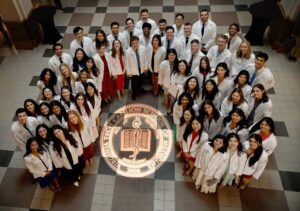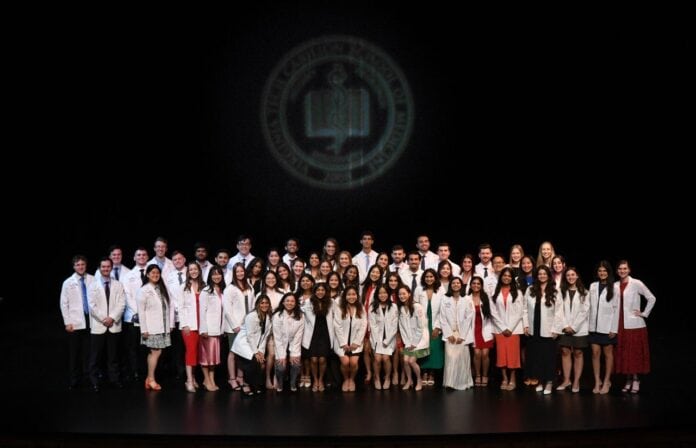As the nation grapples with a growing physician shortage, the Virginia Tech Carilion School of Medicine (VTCSOM) is expanding its impact on the health care workforce. The Roanoke-based medical school welcomed 56 new students this summer to the Class of 2029, the largest incoming class since the school opened in 2010.
The growth is part of a strategic expansion plan aimed at increasing access to medical education and addressing workforce shortages, especially in Virginia and surrounding regions.
“Expanding our class is not just about numbers,” said Dean Lee Learman. “It’s about populating the physician workforce with more VTCSOM graduates who are uniquely well prepared to improve the health of patients and communities. These future physicians will make meaningful contributions in our region of Virginia and beyond.”
More students, more experience
The new class arrives with exceptional credentials. On average, students completed 2,789 hours of clinical experience and 2,342 hours of research before medical school. They represent 38 undergraduate institutions across 20 states, and bring a wide range of experiences, including rural health outreach, community service, and laboratory research.
“Our Class of 2029 brings a depth of hands-on experience that’s vital for real-world patient care,” said Melanie Prusakowski, associate dean for admissions. “We’re excited to support their growth through an innovative curriculum and immersive clinical rotations.”
The medical school takes a holistic approach to admissions, emphasizing service, leadership, and patient-centered values alongside academic achievement. The result is a cohort with both technical skills and a strong commitment to improving health outcomes in communities.

Meeting a critical need
The expansion comes at a crucial moment for the U.S. health care system. According to the Association of American Medical Colleges, the nation could face a shortage of up to 86,000 physicians by 2036. Rural and underserved areas are particularly vulnerable.
By growing its class size, the medical school is directly contributing to efforts to meet that demand.
“This is a long-term investment in the health of our communities,” said Learman. “We know that students who train in Virginia are more likely to stay and practice here. By training more physicians, we’re strengthening our state’s health care pipeline.”
Planning for growth
The expansion is backed by increased investment in faculty, clinical training sites, and infrastructure. The school is upgrading educational facilities and deepening partnerships across the region to support a growing student body.
This year’s increase is part of a multi-year plan to gradually expand class sizes while maintaining the medical school’s focus on small-group learning, early clinical experience, and team-based care.
Since becoming an official college of Virginia Tech in 2018, the medical school has continued to evolve its curriculum and research programs while remaining deeply connected to its clinical partner, Carilion Clinic.
Looking ahead
The Class of 2029 students received their white coats at a ceremony on Aug. 15, signifying the first significant milestone on their path to becoming physicians. Their journey will include problem-based learning, early patient contact, and opportunities to engage in community health initiatives and independent research.
The school’s graduates consistently match into competitive residency programs and many choose to stay in Virginia for their postgraduate training. With more students entering the pipeline, the school is positioned to make an even greater contribution to the region’s health care future. Among the Class of 2029, 13 come from Virginia with four completing their undergraduate studies at Virginia Tech.
“These students represent the future of medicine,” said Prusakowski. “They’re entering the profession at a time of urgent need, and we’re proud to help shape their path.”

By Josh Meyer


